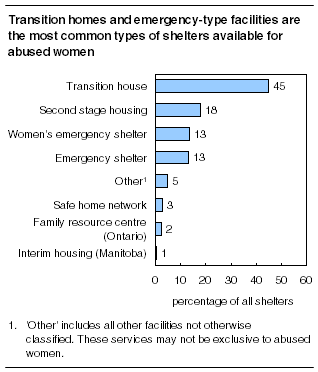Common menu bar links
Shelters for abused women
Archived Content
Information identified as archived is provided for reference, research or recordkeeping purposes. It is not subject to the Government of Canada Web Standards and has not been altered or updated since it was archived. Please "contact us" to request a format other than those available.

Between April 1, 2005 and March 31, 2006, nearly 106,000 women and children were admitted to shelters, most often to escape abuse, according to a new report. While the number of women admitted to shelters to escape abuse has stayed relatively stable during the past nine years, the number of children has fallen substantially.
Children accounted for 41% of these admissions in 2006, compared with 49% in 1998, when Statistics Canada first began collecting these data, the report showed.

The report is based on data from the latest Transition Home Survey (THS), a national survey of residential facilities providing shelter to abused women and their children. The survey, conducted every two years, provides information on the facilities, their services and a snapshot of the clients they serve.
Between 1998 and 2006, admissions of women were relatively stable, declining 3%. However, in 2006 admissions for children fell 4% from 2004 levels and were 25% below the counts in 1998.
The report cited factors that might account for the decline among children, including decreases in the representation of children in the population as a whole. In addition, increased use of emergency-type facilities, some of which have fewer services targeting children, may have contributed to this decline.
During the nine-year period, the number of shelters in Canada increased from 470 to 553. Nearly half of these shelters were transition homes.
However, there has been a decline in the number of transition homes, from 296 in 1998 to fewer than 250 in 2006. At the same time, the number of emergency-type facilities, including women's emergency centres and general emergency shelters, almost tripled, from about 50 to nearly 150. Emergency-type facilities usually provide short-term refuge, typically not beyond a few days.
The survey also captured information on the characteristics of the women and children staying in shelters on a specific "snapshot day," in this case April 19, 2006.
On this date, nearly 4,000 women and 3,500 children stayed in shelters across Canada. About three-quarters of these women were fleeing abuse, frequently from a common-law partner or spouse. Women also stayed in shelters for reasons other than abuse, including housing problems, mental health issues and addictions.
For almost 4 in 10 women in shelters on this date, it was not their first time there.
About 1 shelter in 5 had to refer women and children elsewhere on "snapshot day" because they were unable to accommodate everybody who sought assistance.
In total, more than 300 women and 200 children were turned away, most often because the facility had reached its capacity.
Available on CANSIM: tables 256-0013, 256-0014, 256-0015 and 256-0017.
Definitions, data sources and methods: survey number 3328.
The Juristat: "Canada's Shelters for Abused Women, 2005/2006," Vol. 27, no. 4, (85-002-XIE, free) and Transition Homes in Canada: National, Provincial and Territorial Fact Sheets, 2005/2006 (85-404-XWE, free) are now available from our website. From the Publications module, under Free Internet publications, choose Crime and justice, then Juristat. A paper version (85-002-XPE, $11/$100) is also available.
For further information, or to enquire about the concepts, methods or data quality of this release, contact Client Services (toll-free 1-800-387-2231; 613-951-9023), Canadian Centre for Justice Statistics.

